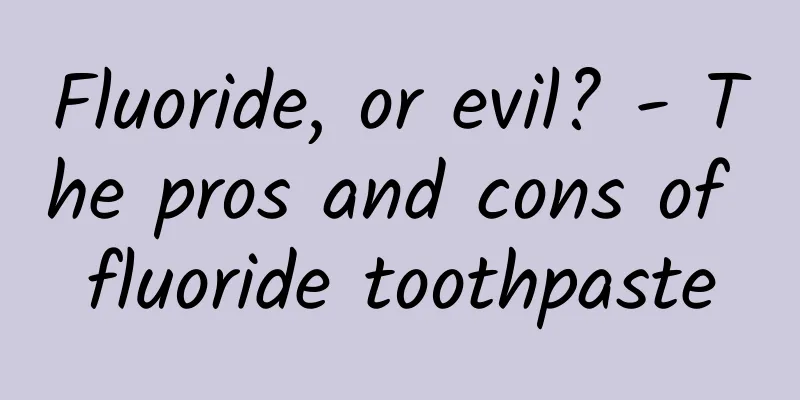Fluoride, or evil? - The pros and cons of fluoride toothpaste

|
Ever since the effectiveness of fluoride in preventing tooth decay was confirmed in the last century, the controversy over whether fluoride is harmful has never stopped... Today I will tell you the pros and cons of fluoride toothpaste. 01 Is fluoride toothpaste harmful? In daily life, the fluoride-containing daily health care product we are most exposed to is fluoride toothpaste. Therefore, fluoride toothpaste is also the most controversial topic. Many advertising articles will deliberately emphasize the harmfulness of fluoride toothpaste, but as long as you pay attention to the product description, you will find that the products they promote actually still contain fluoride. There is a simple fact here, that is, toothpaste is not for eating. So under normal circumstances, no matter how much fluoride toothpaste contains, it will not be harmful. But the problem is that toothpaste can indeed be accidentally ingested. Although the probability is small, it is still possible. People who have this possibility are usually special groups, such as children, who have poor swallowing function. Therefore, saying that fluoride toothpaste is harmful is basically based on abnormal use. 02 Is it harmful to ingest fluoride toothpaste? Whether fluoride toothpaste will cause fluoride poisoning depends on the amount of fluoride. This amount depends on the amount of toothpaste used and its fluoride concentration. Obviously, the greater the amount used, the higher the fluoride concentration, and the more fluoride enters the body. Therefore, there are limits on the amount and fluoride concentration of fluoride toothpaste used by children. The optimal dose of fluoride is 0.05 mg/kg per day. The American Dental Association (ADA) found that, for example, a child weighing 15 kg who brushes his teeth twice a day with a grain of rice-sized toothpaste and swallows all the toothpaste will ingest 0.2 mg of fluoride, a dose of 0.013 mg/kg; if the same child brushes his teeth twice a day with a pea-sized toothpaste and swallows all the toothpaste, he will ingest 0.5 mg of fluoride, resulting in a dose of 0.033 mg/kg. Compared with the former, the latter more than doubles the amount of fluoride ingested. Therefore, considering the potential sources of fluoride such as beverages, foods, toothpaste, supplements, topical applications, and the risk of fluorosis during tooth formation, the ADA recommends using a rice-sized amount of toothpaste from the time the first tooth erupts until age 3, and a pea-sized amount of toothpaste for children aged 3 to 6. This approach maximizes the caries-preventing effect of fluoride while further reducing the risk of fluorosis. 03 Should children’s toothpaste contain fluoride? In fact, the most critical question is whether children should use fluoride toothpaste. In fact, children are the most susceptible group to tooth decay. Fluoride has three functions: 1. It enhances the acid resistance of tooth enamel; 2. It promotes the recalcification of decalcified tooth enamel; 3. It has a certain antibacterial effect. Although its antibacterial effect is still controversial. Therefore, it is particularly important for children at high risk of tooth decay to use fluoride toothpaste. Fluoride poisoning can be avoided by using it according to the dosage described above. In addition to fluoride toothpaste, xylitol also has a certain anti-caries effect, but the effect is slightly worse. Therefore, more toothpastes use fluoride and xylitol together, and xylitol itself can also play the role of a sweetener, which is very suitable for children's toothpaste. Now you know about fluoride toothpaste, right? Isn't it not as scary as you thought? In fact, it is impossible for most adults to eat toothpaste, and even if they accidentally eat it, the amount is very small; children can also prevent fluoride poisoning by controlling the amount and using children's special toothpaste. Fluoride toothpaste is not scary, what is scary is tooth decay. |
<<: Why are green mandarin oranges so sweet? Should I buy yellow or green mandarin oranges?
>>: Will mandarin oranges become sweeter as they age? When do mandarin oranges ripen?
Recommend
Sincere advice: Walking more than 7,000 steps a day can significantly reduce the mortality rate!
As the saying goes, if you take a hundred steps a...
There are benefits to cleaning your ears! But I don’t recommend you to…
It is said that it is also indispensable for the ...
Analysis of the causes of dyspnea during sleep during late pregnancy
Every woman will go through the 10-month pregnanc...
My aunt has a lot of blood clots
The importance of menstruation to women is self-e...
How can girls with big bones lose weight?
Girls with big frames cannot appear slim visually...
How to make boxwood bonsai and how to grow boxwood bonsai vigorously
Boxwood is very common in our daily life. Due to ...
What kind of paintings are suitable for the simple style entrance? How to choose simple style paintings for the entrance?
We all know that the choice of decorative paintin...
What is the correct way to clean the vagina?
The vagina is a very important organ for female f...
What are the precautions for uterine curettage surgery?
Curettage surgery, also known as abortion surgery...
These 3 breast cancer-related eating and drinking rumors are all false
At present, breast cancer has become the most com...
What causes vaginal bleeding during menopause?
During menopause, women are more likely to develo...
How can women lose weight on their legs most effectively?
Whether for boys or girls, having a pair of long ...
Does scanty menstruation affect conception?
When women are preparing to have a baby, they nee...
Can patients with ovarian cysts eat leeks?
Ovarian cysts have become a gynecological disease...









